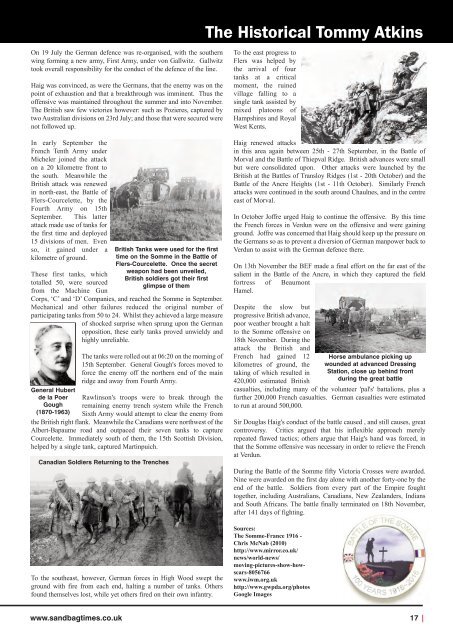Create successful ePaper yourself
Turn your PDF publications into a flip-book with our unique Google optimized e-Paper software.
<strong>The</strong> Historical Tommy Atkins<br />
On 19 July the German defence was re-organised, with the southern<br />
wing forming a new army, First Army, under von Gallwitz. Gallwitz<br />
took overall responsibility for the conduct of the defence of the line.<br />
Haig was convinced, as were the Germans, that the enemy was on the<br />
point of exhaustion and that a breakthrough was imminent. Thus the<br />
offensive was maintained throughout the summer and into <strong>No</strong>vember.<br />
<strong>The</strong> British saw few victories however: such as Pozieres, captured by<br />
two Australian divisions on 23rd July; and those that were secured were<br />
not followed up.<br />
In early September the<br />
French Tenth Army under<br />
Micheler joined the attack<br />
on a 20 kilometre front to<br />
the south. Meanwhile the<br />
British attack was renewed<br />
in north-east, the Battle of<br />
Flers-Courcelette, by the<br />
Fourth Army on 15th<br />
September. This latter<br />
attack made use of tanks for<br />
the first time and deployed<br />
15 divisions of men. Even<br />
so, it gained under a<br />
kilometre of ground.<br />
<strong>The</strong>se first tanks, which<br />
totalled 50, were sourced<br />
from the Machine Gun<br />
Corps, ‘C’ and ‘D’ Companies, and reached the Somme in September.<br />
Mechanical and other failures reduced the original number of<br />
participating tanks from 50 to <strong>24</strong>. Whilst they achieved a large measure<br />
of shocked surprise when sprung upon the German<br />
opposition, these early tanks proved unwieldy and<br />
highly unreliable.<br />
General Hubert<br />
de la Poer<br />
Gough<br />
(1870-1963)<br />
British Tanks were used for the first<br />
time on the Somme in the Battle of<br />
Flers-Courcelette. Once the secret<br />
weapon had been unveiled,<br />
British soldiers got their first<br />
glimpse of them<br />
<strong>The</strong> tanks were rolled out at 06:20 on the morning of<br />
15th September. General Gough's forces moved to<br />
force the enemy off the northern end of the main<br />
ridge and away from Fourth Army.<br />
Rawlinson's troops were to break through the<br />
remaining enemy trench system while the French<br />
Sixth Army would attempt to clear the enemy from<br />
the British right flank. Meanwhile the Canadians were northwest of the<br />
Albert-Bapaume road and outpaced their seven tanks to capture<br />
Courcelette. Immediately south of them, the 15th Scottish Division,<br />
helped by a single tank, captured Martinpuich.<br />
Canadian Soldiers Returning to the Trenches<br />
To the southeast, however, German forces in High Wood swept the<br />
ground with fire from each end, halting a number of tanks. Others<br />
found themselves lost, while yet others fired on their own infantry.<br />
To the east progress to<br />
Flers was helped by<br />
the arrival of four<br />
tanks at a critical<br />
moment, the ruined<br />
village falling to a<br />
single tank assisted by<br />
mixed platoons of<br />
Hampshires and Royal<br />
West Kents.<br />
Haig renewed attacks<br />
in this area again between 25th - 27th September, in the Battle of<br />
Morval and the Battle of Thiepval Ridge. British advances were small<br />
but were consolidated upon. Other attacks were launched by the<br />
British at the Battles of Transloy Ridges (1st - 20th October) and the<br />
Battle of the Ancre Heights (1st - 11th October). Similarly French<br />
attacks were continued in the south around Chaulnes, and in the centre<br />
east of Morval.<br />
In October Joffre urged Haig to continue the offensive. By this time<br />
the French forces in Verdun were on the offensive and were gaining<br />
ground. Joffre was concerned that Haig should keep up the pressure on<br />
the Germans so as to prevent a diversion of German manpower back to<br />
Verdun to assist with the German defence there.<br />
On 13th <strong>No</strong>vember the BEF made a final effort on the far east of the<br />
salient in the Battle of the Ancre, in which they captured the field<br />
fortress of Beaumont<br />
Hamel.<br />
Despite the slow but<br />
progressive British advance,<br />
poor weather brought a halt<br />
to the Somme offensive on<br />
18th <strong>No</strong>vember. During the<br />
attack the British and<br />
French had gained 12<br />
kilometres of ground, the<br />
taking of which resulted in<br />
420,000 estimated British<br />
casualties, including many of the volunteer 'pal's' battalions, plus a<br />
further 200,000 French casualties. German casualties were estimated<br />
to run at around 500,000.<br />
Sir Douglas Haig's conduct of the battle caused , and still causes, great<br />
controversy. Critics argued that his inflexible approach merely<br />
repeated flawed tactics; others argue that Haig's hand was forced, in<br />
that the Somme offensive was necessary in order to relieve the French<br />
at Verdun.<br />
During the Battle of the Somme fifty Victoria Crosses were awarded.<br />
Nine were awarded on the first day alone with another forty-one by the<br />
end of the battle. Soldiers from every part of the Empire fought<br />
together, including Australians, Canadians, New Zealanders, Indians<br />
and South Africans. <strong>The</strong> battle finally terminated on 18th <strong>No</strong>vember,<br />
after 141 days of fighting.<br />
Sources:<br />
<strong>The</strong> Somme-France 1916 -<br />
Chris McNab (2010)<br />
http://www.mirror.co.uk/<br />
news/world-news/<br />
moving-pictures-show-howscars-8056766<br />
www.iwm.org.uk<br />
http://www.gwpda.org/photos<br />
Google Images<br />
Horse ambulance picking up<br />
wounded at advanced Dressing<br />
Station, close up behind front<br />
during the great battle<br />
www.sandbagtimes.co.uk 17 |


















